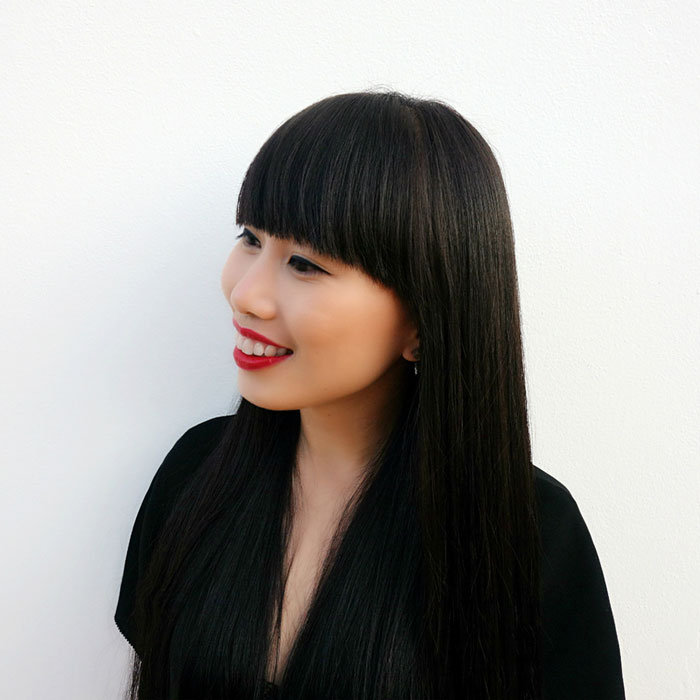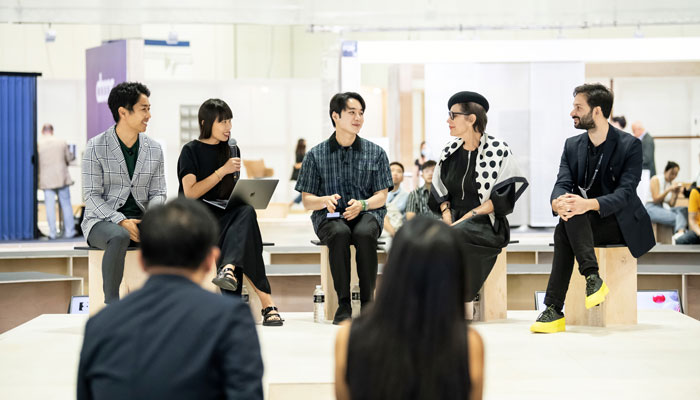In Conversation with Yoko Choy
Between the 21st and 23rd of September FIND – Design Fair Asia will take place at Marina Bay Sands, an anchor event of Design Marketplace at Singapore Design Week 2023. The event promises to be the premier gathering for Interior Designers, Architects, Fit-Out Contractors, and Retailers, enabling visitors to engage in meaningful business interactions with top-tier global brands and manufacturers.
This year’s edition also includes a Global Summit to bring together thought leaders, renowned craftspeople, and the creative community to discuss the most important topics driving the industry today. The Global Summit has been curated by China editor of Wallpaper* Magazine Yoko Choy who has devised a schedule enabling leading industry insiders and delegates to enjoy a programme of seminars which welcomes over 50 speakers to the stage.
We took the opportunity to speak with Yoko about her career in design journalism and communications consultancy, as well as her own personal mission to drive increased cultural exchange between the East and the West.

Yoko Choy, Design Writer and Creative Consultant
Please could you walk me through your career journey and how it led you to becoming the China Editor of Wallpaper magazine in 2018?
I trained as a communications designer and studied journalism at university, so my love for publications and magazines dates back to well before I even started my university journey. I knew that I wanted to work in the publishing industry after graduation, and that’s precisely what I did.
I first started as a graphic designer for a magazine in Taipei, where I worked for two years. I discovered that working at a desk all day, without access to the creative scene, wasn’t what I wanted to continue with for my career. Thankfully, a very good opportunity came my way from a magazine I particularly admired, called City Magazine, which is the longest running cultural, fashion and lifestyle magazine in Hing Kong.
City Magazine was looking for an Editor which had no experience, a white paper, someone who they could train and who would bring a fresh perspective. So, I joined them not knowing how to edit a magazine and they gave me extremely good training, the role helped me to define which field I wanted to move into.

Hong Kong
At the time City Magazine had a unique format for each issue. Each issue featured one specific creative scene, Japan, Germany, New York etc and this gave me a lot of access to the creative industry and trends from each city or country that I visited.
I decided to step away from the in-house team and moved into freelance work, at the same time I worked as a consultant for a furniture importer which gave me access to many international furniture, lighting, and accessories brands. I also worked with interior and architecture studios based locally which taught me how to look at a design item and how to approach the design and consumer market.
By chance, I met the previous Editor in Chief of Wallpaper magazine, Tony Chambers, on a press trip to Dubai. He spoke to me about becoming a contributor, and I started working with the Wallpaper team, who taught me a great deal. For the past six years, I have held the role of China Editor for the magazine.
Were there specific articles which were pivotal in the progression of your career as a design writer and editor?
I don’t think there are pivotal articles or moments which changed the trajectory of my career, I think the journey has been an accumulation of experience and knowledge.
I always tell people that the peak of my career as a design journalist happened very early on. I was sent to Brazil for an edition of City Magazine, where I was given the extraordinary opportunity to interview Oscar Niemeyer. I was so excited, not only because he was a Modernist pioneer and a living legend, but also because his way of creation and his lifestyle moved me so much. I remember our exchange, despite speaking through an interpreter; the energy, the passion, were immense.
You mentioned that you balance your journalism and editorial work with working as a communications consultant, could you tell me more about this side of your career?
This work started through my work for the furniture importer in Hong Kong at a time that the Chinese market was still new to a lot of international brands. Because of this experience international brands often ask for my opinion and wish to discuss ideas on how they can approach and communicate with potential customers in Hong Kong and China with a view to entering the market. It was a natural progression from this work into assisting these brands with activities including trade shows and exhibitions.
In 2015 I began working with Beijing Design Week which gave me the chance to really dive into the create scene in China and to gain a better understanding of design in China. I continued to spend time in different cities in order to explore the design scenes and to understand the wider market.
As well as working with international brands wishing to entre the Chinese market I also began to work with Chinese studios to help them to engage overseas.
Within your work are there concepts being discussed that you feel are particularly important to communicate?
I believe that the biggest topic is: What is Chinese design?
The general impression when you explore Chinese design often focuses on cultural symbols, colours, and details that emphasize the aesthetic of the object. What I find interesting about Chinese design today is that due to their immense manufacturing power, resources, and techniques, they can harness this capacity to create designs that address contemporary living challenges. This goes far beyond aesthetics and is a topic I’m particularly interested in discussing.
Are there ways of communicating this which are particularly creative?
I think that the most efficient and direct approach is to increase exposure on the international stage. It has been particularly tough for the brands from China over the past three years due to pandemic and the restrictions this placed on being able to showcase work and sustain relationships.
At Milan Design Week we saw many Chinese brands coming out, not only to showcase their work, but to start the knowledge exchange again and re-establish their international network. I feel strongly that these interpersonal and cultural exchanges will help people outside of China to understand the younger generation and what is happening now in Chinese design.
Your mission, as a multicultural and multilingual creative commentator, is to create and raise awareness of the importance of a common creative language and cross-cultural exchange between the East and West, why is this something so close to your heart?
My background growing up in Hong Kong was always very culturally mixed, so I am accustomed to working with people outside of my own culture. This created a window for me to start understanding Chinese culture within the context of the international market.
The more I speak with Chinese creatives and the more I explore Chinese cities, the more passionate I am to dig deeper. I want to tell the story of contemporary China whilst at the same time bringing in influences from outside to the Chinese creative scene.
Before the pandemic we saw a surge in the activity and communication exchange between the East and the West, but this was cut of completely during the pandemic. To build a new platform, and to create the conversation again with a common creative language, is something which is important to me.
When you use the phrase ‘common creative language’ what does that look like in practise?
Good design is a way to solve problems in life. When we are striving towards the same goals we are communicating through a common creative language.
As well as local community challenges, globally we have common problems including the climate crisis. Because of the information exchange available to us and the experiences which have been accumulated in China, especially in manufacturing and urban development, we have a lot of experience to share with the world which can help the global community to resolve these common problems.
Can you share examples of how you, or others, have been successful in achieving your goals and the impact this is having?
During the pandemic, I wrote a book for Qeelin, a luxury jewellery brand founded by Hong Kong designer Dennis Chan. It is the first luxury jewellery brand to be bought by the Kering group. Qeelin uses elements from Chinese history to create objects which are extremely contemporary and, as a creative coming from Hong Kong myself, it is a very proud moment for us to have a truly international brand that resonates Chinese culture and contemporary design.
I also worked on a book for the German automobile designer Peter Schreyer. He is now the Executive Design Advisor for the Hyundai Motor Group, which is a South Korean company based in Seoul. The way in which they work together on new ideas, concepts, and technology, to create products which are sold internationally is very interesting. Peter is also involved in the cultural development of the company, leading the company to be recognised for supporting art, culture and the music industry. I think that this is a good example of an Asian brand which can create international interest routed in local culture.
What does the future hold for cross-cultural exchange between the east and west? What could a common creative language mean to society? What can we look forward to seeing from your work in the near future?
The ultimate goal of establishing a common creative language is to foster a harmonious society. The better we comprehend each other’s cultures, the more willing we become to contribute to one another’s communities.
This kind of mutual understanding and cultural exchange can contribute significantly to the attainment of harmony because it involves a personal connection and a deep understanding of one another. I believe this is the essence of design – it’s about improving how we live, enhancing our perspectives, and ultimately contributing to peace and shared understanding.
At the moment I am working on an Asian collectable design collection for a gallery in Dubia. Our schedule is to launch the collection in March 2024 during the Dubia’s art week.
FIND – Design Fair Asia will take place September 21st – 23rd at Marina Bay Sands, Singapore, could you tell me about your role in the creation of the FIND – Global Summit?

FIND – Design Fair Asia
My role is to curate the Global Summit which builds an additional layer onto the event, allowing the trade show not to solely focus on trade and business, but to provide a platform for knowledge exchange and engagement.
The advantage of holding this event in Singapore is that the city is a hub for the region, for business and creativity, making it an ideal location for the exchange of ideas. It is also an international city and people are used to gathering here to trade, talk and connect.
The knowledge platform we create will be its own hub for visitors to find meaningful conversation and business links.
What are your personal highlights from within the programme you have created?
We have a very special programme where each day is dedicated to a specific topic. Day one is focused on architecture and innovation. Day three will focus on hospitality and interior design.
Day two, which is particularly special to me, celebrates Asian creatives, brands, institutions, and more. The day includes representatives from 10 Asian countries coming to Singapore to share their experiences as established and emerging brands. Up-and-coming designers will also be sharing their challenges and how to create a brand from Asia to become internationally successful. This day is special to me because I don’t think that any other international platform or event has ever previously dedicated a day to Asian creativity.”




